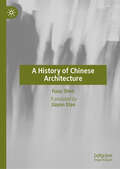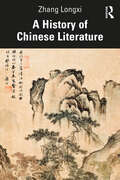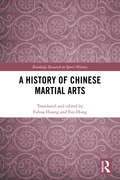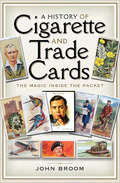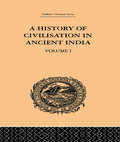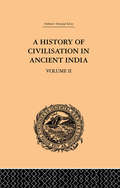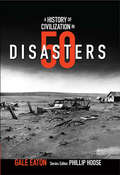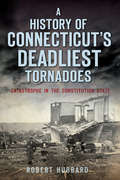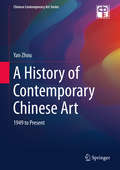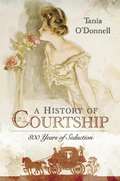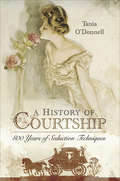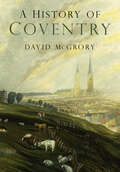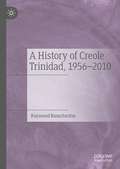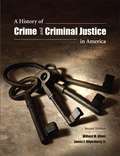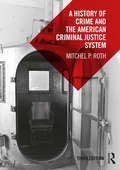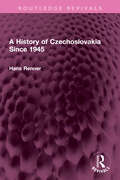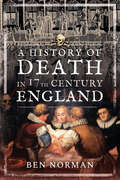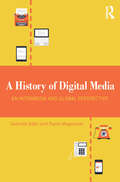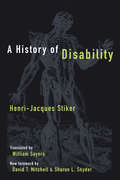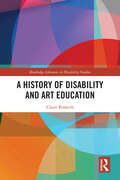- Table View
- List View
A History of Chinese Architecture
by Fuxu ShenThis book provides a comprehensive examination of the architectural evolution of China from antiquity to the early modern, modern, and contemporary ages. A comprehensive examination of the evolution of Chinese architecture is presented in nine chapters, offering a penetrating survey of the subject matter for both learners and professionals. Each chapter illuminates the architectural styles, cultural implications, social significance, and innovations that have shaped the development of Chinese architecture across all dynasties and epochs, from the prehistoric era to the present day. Furthermore, the book draws on past predictions and promising trends in the future of Chinese architecture, thus offering a distinctive perspective on the history of Chinese architecture.
A History of Chinese Literature
by Zhang LongxiZhang Longxi, an internationally renowned scholar of Chinese and comparative literature, is your guide to the three-millennia-long history of Chinese literature from the remote antiquity of oracle bones to contemporary works. Professor Zhang charts the development of the major literary forms in Chinese, including poetry, prose, song lyrics, and plays, and introduces the most famous poets and writers and their representative texts. Taking a period-based approach through the major dynasties, he places these forms, texts, and authors within their historical contexts and tells the fascinating story of Chinese literature with copious examples in English translation. He writes in a clear and accessible style and assumes no prior knowledge of Chinese history or Chinese literature. This book is an ideal introduction for students and the general readers who want to get a broad but thorough overview of Chinese literature in all its richness and diversity.
A History of Chinese Martial Arts (Routledge Research in Sports History)
by Fan Hong Fuhua HuangChinese martial arts have a long, meaningful history and deep cultural roots. They blend the physical components of combat with strategy, philosophy and tradition, distinguishing them from Western sports. A History of Chinese Martial Arts is the most authoritative study ever written on this topic, featuring contributions from leading Chinese scholars and practitioners. The book provides a comprehensive overview of all types of Chinese martial arts, from the Pre-Qin Period (before 222 BC) right up to the present day in the People’s Republic of China, with each chapter covering a different period in Chinese history. Including numerous illustrations of artefacts, weaponry and historical drawings and documents, this book offers unparalleled insight into the origins, development and contemporary significance of martial arts in China. This is a fascinating read for researchers and students working in sports history, Chinese sport and Chinese Studies.
A History of Cigarette and Trade Cards: The Magic Inside the Packet
by John BroomHow trading cards captured the popular culture—from war to sports, science to celebrities—with tips on how to start and develop your own collection. The collection of picture cards has fascinated generations of children and adults since the late nineteenth century. Between 1900 and 1940, cartophily, as the hobby became known, became widespread as hundreds of millions of attractive cards were issued, usually with packets of cigarettes. These cards give us a unique insight into the cultural history of the period. Although the production of cigarette and other trade cards has declined in recent decades, millions of people worldwide now collect trading cards and stickers issued by the likes of Topps and Panini. This attractive and extensively illustrated guide to collecting cigarette and other trade cards gives the reader a lively history of the hobby, and offers the collector some valuable advice on how to begin and maintain a collection. The wide variation of themes of card issues is explored, with many of the stories behind the cards revealed. It will appeal to novice and established card collectors, and those with an interest in twentieth century social and cultural history.
A History of Civilisation in Ancient India: Based on Sanscrit Literature: Volume I
by Romesh Chunder DuttFirst Published in 2000. Routledge is an imprint of Taylor & Francis, an informa company.
A History of Civilisation in Ancient India: Based on Sanscrit Literature: Volume II
by Romesh Chunder DuttFirst Published in 2000. This title is Volume 4 in the 11-volume series titled India: History, Economy and Society, one of the Trüber's Oriental Series. This title tackles the great task of compiling, for the first time, a connected and clear history of the Ancient Hindus. The first chapters on the Vedic Age were commenced in April 1887, the last chapters on the Puranic Age have been revised in March 1890. The entire edition of a thousand copies has been nearly exhausted for this collection.
A History of Civilization in 50 Disasters (History in #50)
by Phillip Hoose Gale EatonThe earth shakes and cracks open. Volcanoes erupt. Continents freeze, bake, and flood. Droughts parch the land. Wildfires and hundred-year storms consume anything in their paths. Invisible clouds of disease and pestilence probe for victims. Tidal waves sweep ashore from the vast sea. The natural world is a dangerous place, but one species has evolved a unique defense against the hazards: civilization. Civilization rearranges nature for human convenience. Clothes and houses keep us warm; agriculture feeds us; medicine fights our diseases. It all works--most of the time. But key resources lie in the most hazardous places, so we choose to live on river flood plains, on the slopes of volcanoes, at the edge of the sea, above seismic faults. We pack ourselves into cities, Petri dishes for germs. Civilization thrives on the edge of disaster. And what happens when natural forces meet molasses holding tanks, insecticides, deepwater oil rigs, nuclear power plants? We learn the hard way how to avoid the last disaster--and maybe how to create the next one. What we don't know can, indeed, hurt us. This book's white-knuckled journey from antiquity to the present leads us to wonder at times how humankind has survived. And yet, as Author Gale Eaton makes clear, civilization has advanced not just in spite of disasters but in part because of them. Hats off to human resilience, ingenuity, and perseverance! They've carried us this far; may they continue to do so into our ever-hazardous future. The History in 50 series explores history by telling thematically linked stories. Each book includes 50 illustrated narrative accounts of people and events--some well-known, others often overlooked--that, together, build a rich connect the-dots mosaic and challenge conventional assumptions about how history unfolds. Dedicated to the premise that history is the greatest story ever told. Includes a mix of "greatest hits" with quirky, surprising, provocative accounts. Challenges readers to think and engage. Includes a glossary of technical terms; sources by chapter; teaching resources as jumping-off points for student research; and endnotes.
A History of Colonial India: 1757 to 1947
by Himanshu Roy and Jawaid AlamThis volume brings together interdisciplinary perspectives on British colonial rule in India. It draws on sociology, history, and political science to look at key events and social process, between 1757 to 1947, to provide a comprehensive understanding of the colonial history. It begins with the introductory backdrop of the British East India Company when its ship docked at Surat in 1603 and ends with the partition and independence in 1947. A compelling read, the book explores a range of key themes which include: – Early colonial polity, economic transformation, colonial educational policies, and other initial developments; – The revolt of 1857 and its aftermath; – Colonial subjectivities and ethnographic interventions, colonial capitalism and its insititutions, – Constitutional developments in colonial India; – Early nationalist politics, the rise of Indian National Congress, the role of Gandhi in nationalist politics, and the Quit India movement; – Social movements and gender politics under the colonial rule; – Partition of India and independence. Accessibly written and exhaustive, this volume will be essential reading for students, teachers, scholars, and researchers of political science, history, sociology and literature.
A History of Competitive Gaming (Routledge Studies in Cultural History)
by Lu ZhouxiangCompetitive gaming, or esports – referring to competitive tournaments of video games among both casual gamers and professional players – began in the early 1970s with small competitions like the one held at Stanford University in October 1972, where some 20 researchers and students attended. By 2022 the estimated revenue of the global esports industry is in excess of $947 million, with over 200 million viewers worldwide. Regardless of views held about competitive gaming, esports have become a modern economic and cultural phenomenon. This book studies the full history of competitive gaming from the 1970s to the 2010s against the background of the arrival of the electronic and computer age. It investigates how competitive gaming has grown into a new form of entertainment, a sport-like competition, a lucrative business and a unique cultural sensation. It also explores the role of competitive gaming in the development of the video game industry, making a distinctive contribution to our knowledge and understanding of the history of video games. A History of Competitive Gaming will appeal to all those interested in the business and culture of gaming, as well as those studying modern technological culture.
A History of Connecticut's Deadliest Tornadoes: Catastrophe in the Constitution State (Disaster)
by Robert HubbardThe Wallingford tornado of 1878 took less than two minutes, but it killed at the rate of one person per second. Twisters in Connecticut are incredibly rare, but they're often disastrous and sometimes deadly. The Windsor tornado of 1979 destroyed a field of aircraft that had survived World War II. The 1787 Wethersfield tornado ripped off a barn roof in New Britain, traveled on to Newington and finally subsided in Wethersfield after destroying a family farm. Locals remember the 1989 cyclone that ripped through Hamden and cost the state millions of dollars in repairs. Join local author Robert Hubbard as he shares the tales of these natural disasters and those who witnessed them.
A History of Contemporary Chinese Art: 1949 to Present (Chinese Contemporary Art Series)
by Yan ZhouChinese art has experienced its most profound metamorphosis since the early 1950s, transforming from humble realism to socialist realism, from revolutionary art to critical realism, then avant-garde movement, and globalized Chinese art. With a hybrid mix of Chinese philosophy, imported but revised Marxist ideology, and western humanities, Chinese artists have created an alternative approach – after a great ideological and aesthetic transition in the 1980s – toward its own contemporaneity though interacting and intertwining with the art of rest of the world. This book will investigate, from the perspective of an activist, critic, and historian who grew up prior to and participated in the great transition, and then researched and taught the subject, the evolution of Chinese art in modern and contemporary times. The volume will be a comprehensive and insightful history of the one of the most sophisticated and unparalleled artistic and cultural phenomena in the modern world.
A History of Courtship: 800 Years of Seduction
by Tania O'DonnellTania O’Donnell takes the reader on a journey from medieval Courtly Love, through to the sexual license of the Restoration, and Victorian propriety. Pick up historical ‘dating tips,’ from how to court (or be courted), write romantic love letters, give and receive gifts, propose and pose as a sighing swain.The book takes a historical approach to the problem of finding a mate, with case studies of classic romantic mistakes and plenty of unusual tales. In the 14th century young men tried to impress the ladies with their footwear, donning shoes with pointed toes so long that they had to be secured with whalebone—presumably because size mattered!A History of Courtship is an entertaining and enlightening look at seduction over the centuries.
A History of Courtship: 800 Years of Seduction Techniques
by Tania O'DonnellExplore 800 years of lust, love, and loss.The author takes the reader on a journey from medieval courtly love, through to the sexual license of the Restoration, and Victorian propriety. Pick up historical 'dating tips', from how to court (or be courted); write romantic love letters, give and receive gifts, propose and pose as a sighing swain. A historical approach to the problem of finding a mate, with case studies of classic romantic mistakes and plenty of unusual tales. In the fourteenth century young men tried to impress the ladies with their footwear, donning shoes with pointed toes so long that they had to be secured with whalebone presumably because size mattered!
A History of Coventry
by David McGroryThe author, well known as the writer of more books on the city than anyone, explores Coventry's history from Roman times through Earl Leofric, Godiva and the Norman castle, to monastic houses, including St Mary's priory.Coventry has a rich medieval heritage, and rose to power in the Wars of the Roses, when the royal court moved there. Major themes in the city's history are discussed, through previously unknown source material, covering the Siege and Civil War, education, health, the church, crime and punishment, and industries from medieval weaving to modern car-building.
A History of Creole Trinidad, 1956-2010
by Raymond RamcharitarThis book offers a history of post-Independence Trinidad and Tobago. It explores how culture and politics have operated in tandem to shape the society. Drawing on a wide range of sources, including literature, government reports, official statistics, the press and the Carnival, it critically analyses the popular conception of creolization as the driving force in modern Trinidad and Tobago. Ultimately, the book examines the way in which Trinidad and Tobago's unique ethnic and political ecosystems contribute to its national character.
A History of Crime and Criminal Justice in America
by Willard Oliver James HilgenbergThis updated second edition provides an overview of the origin and development of the American criminal justice system, from the founding of Jamestown, the first English settlement, and tracing history to the events of September 11, 2001. Each chapter begins with an overview of the social, political, and economic forces that shaped society during a given era in American history. What follows, then, is an overview of the ordinary and extraordinary crimes of each era, and how the criminal justice system (police, courts, corrections, and juvenile justice) responded to these crimes, thereby conveying how the system developed over time.
A History of Crime and the American Criminal Justice System
by Mitchel P. RothThis book offers a history of crime and the criminal justice system in America, written particularly for students of criminal justice and those interested in the history of crime and punishment. It follows the evolution of the criminal justice system chronologically and, when necessary, offers parallels between related criminal justice issues in different historical eras. From its antecedents in England to revolutionary times, to the American Civil War, right through the twentieth century to the age of terrorism, this book combines a wealth of resources with keen historical judgement to offer a fascinating account of the development of criminal justice in America. A new chapter brings the story up to date, looking at criminal justice through the Obama era and the early days of the Trump administration. Each chapter is broken down into four crucial components related to the American criminal justice system from the historical perspective: lawmakers and the judiciary; law enforcement; corrections; and crime and punishment. A range of pedagogical features, including timelines of key events, learning objectives, critical thinking questions and sources, as well as a full glossary of key terms and a Who’s Who in Criminal Justice History, ensures that readers are well-equipped to navigate the immense body of knowledge related to criminal justice history. Essential reading for Criminal Justice majors and historians alike, this book will be a fascinating text for anyone interested in the development of the American criminal justice system from ancient times to the present day.
A History of Curiosity: The Theory of Travel 1550-1800 (Studies in Anthropology and History)
by Justin StaglFirst Published in 2002. Routledge is an imprint of Taylor & Francis, an informa company.
A History of Czechoslovakia Since 1945 (Routledge Revivals)
by Hans RennerFirst published in 1989, A History of Czechoslovakia Since 1945 is a comprehensive account of Czechoslovakia under Communist rule, tracing events from 1945 to 1990. The author focuses on the last twenty years in particular, when the Prague Spring offered a brief period of liberalization, but was followed by harder times, with the hope of change fading, and society becoming paralyzed. Dr. Renner describes vividly the country’s fortunes under the Soviet rule of Stalin and Brezhnev, and how it pioneered the policy of glasnost during the Prague Spring of 1968. The book concludes with a special look at the influence of Gorbachev’s glasnost on the regime of Czechoslovakia. Dr. Renner combines a chronological overview with a passionate yet scholarly discussion of underlying political, economic, and cultural issues and developments, making this book invaluable as an authoritative and lucid account of Czechoslovak history, as well as an explanation of the role this country and in events played in the shaping of modern Europe.
A History of Czechs and Jews: A Slavic Jerusalem (Routledge Jewish Studies Series)
by Martin WeinWas Israel founded by Czechoslovakia? A History of Czechs and Jews examines this question and the resulting findings are complex. Czechoslovakia did provide critical, secret military sponsorship to Israel around 1948, but this alliance was short-lived and terminated with the Prague Trial of 1952. Israel’s "Czech guns" were German as much as Czech, and the Soviet Union strongly encouraged Czechoslovakia’s help for Israel. Most importantly however, the Czechoslovak-Israeli military cooperation was only part of a much larger picture. Since the mid-1800s, Czechs and Jews have been systematically comparing themselves to each other in literature, music, politics, diplomacy, media, and historiography. A shared perception of similar fates of two small nations trapped between East and West, in constant existential danger, helped forge a Czech-Jewish "national friendship" amid periods of estrangement. Yet, this Czech-Jewish national friendship, an idea that can be traced from Masaryk and Kafka via Weizman and Ben Gurion to Havel and Netanyahu, was more myth than reality. Relations were often mixed and highly dependent on larger historical developments affecting Central Europe and the Middle East. As the Czech Republic emerges as Israel’s main EU ally, this book provides a timely analysis of this old-new alliance and is essential reading for students and scholars with an interest in History and Jewish Studies.
A History of Death in 17th Century England
by Ben NormanA look at the constant confrontation with mortality the English experienced in a time of plague, smallpox, civil war, and other calamities. In the lives of the rich and poor alike in seventeenth-century England, death was a hovering presence, much more visible in everyday existence than it is today. It is a highly important and surprisingly captivating part of the epic story of England during the turbulent years of the 1600s. This book guides readers through the subject using a chronological approach, as would have been experienced by those living in the country at the time, beginning with the myriad causes of death, including rampant disease, war, and capital punishment, and finishing with an exploration of posthumous commemoration, including mass interments in times of disease, the burial of suicides, and the unconventional laying to rest of English Catholics. Although the people of the seventeenth century did not fully realize it, when it came to the confrontation of mortality they were living in wildly changing times.
A History of Digital Media: An Intermedia and Global Perspective
by Paolo Magaudda Gabriele BalbiFrom the punch card calculating machine to the personal computer to the iPhone and more, this in-depth text offers a comprehensive introduction to digital media history for students and scholars across media and communication studies, providing an overview of the main turning points in digital media and highlighting the interactions between political, business, technical, social, and cultural elements throughout history. With a global scope and an intermedia focus, this book enables students and scholars alike to deepen their critical understanding of digital communication, adding an understudied historical layer to the examination of digital media and societies. Discussion questions, a timeline, and previously unpublished tables and maps are included to guide readers as they learn to contextualize and critically analyze the digital technologies we use every day.
A History of Diplomacy, Spatiality, and Islamic Ideals (ISSN)
by Malika DekkicheInspired by the “spatial turn,” this volume links for the first time the study of diplomacy and spatiality in the premodern Islamicate world to understand practices and meanings ascribed to territory and realms.Debates on the nature of the sovereign state as a territorially defined political entity are closely linked to discussions of “modernity” and to the development of the field of international relations. While scholars from different disciplinary backgrounds have long questioned the existence of such a concept as a “territorial state,” rarely have they ventured outside the European context. A closer look at the premodern Islamicate world, however, shows that “space” and “territoriality” highly mattered in the conception of interstate contacts and in the conduct and evolution of diplomacy. This volume addresses these issues over the longue durée (thirteenth to nineteenth centuries) and from various approaches and sources, including letters, chancery manuals, notarial records, travelogues, chronicles, and fatwas. The contributors also explore the various diplomatic practices and understandings of spatiality that were present throughout the Islamicate world, from Al-Andalus to the Ottoman realms.The book will be of interest to students and researchers in a range of disciplines, including international relations, diplomatic history, and Islamic studies.
A History of Disability (Corporealities: Discourses Of Disability)
by Henri-Jacques StikerThe first book to attempt to provide a framework for analyzing disability through the ages, Henri-Jacques Stiker's now classic A History of Disability traces the history of western cultural responses to disability, from ancient times to the present. The sweep of the volume is broad; from a rereading and reinterpretation of the Oedipus myth to legislation regarding disability, Stiker proposes an analytical history that demonstrates how societies reveal themselves through their attitudes towards disability in unexpected ways. Through this history, Stiker examines a fundamental issue in contemporary Western discourse on disability: the cultural assumption that equality/sameness/similarity is always desired by those in society. He highlights the consequences of such a mindset, illustrating the intolerance of diversity and individualism that arises from placing such importance on equality. Working against this thinking, Stiker argues that difference is not only acceptable, but that it is desirable, and necessary. This new edition of the classic volume features a new foreword by David T. Mitchell and Sharon L. Snyder that assesses the impact of Stiker’s history on Disability Studies and beyond, twenty years after the book’s translation into English. The book will be of interest to scholars of disability, historians, social scientists, cultural anthropologists, and those who are intrigued by the role that culture plays in the development of language and thought surrounding people with disabilities.
A History of Disability and Art Education (Routledge Advances in Disability Studies)
by Claire PenkethDrawing on recent theoretical frameworks from critical disability studies and art education including normalcy, ableism, disability and Crip theory, this book offers an analysis of the conceptualisation of ability in art education and its relationship with disability. Drawing on the work of Cizek and Lowenfeld in Austria, Ruskin and Richardson in England and Dewey and Eisner in the United States, it critically examines the influence of ideas such as the dominance of vision and visuality; the emergence of psychological perspectives; the Child Art Movement; the implications of assessment regimes; and the relevance of art education as a critical social practice on the production of disability. Offering a sustained inquiry into the differential values attributed to learners and their work and the implications of this for framing our understanding of disability in art education, this book shows that although art educators have frequently advocated for the universal appeal and importance of art education, they have done so within historical contexts that have produced and determined problematic ideas regarding disability. It will be of interest to all scholars and students of disability studies, art in education, art history and education studies.
